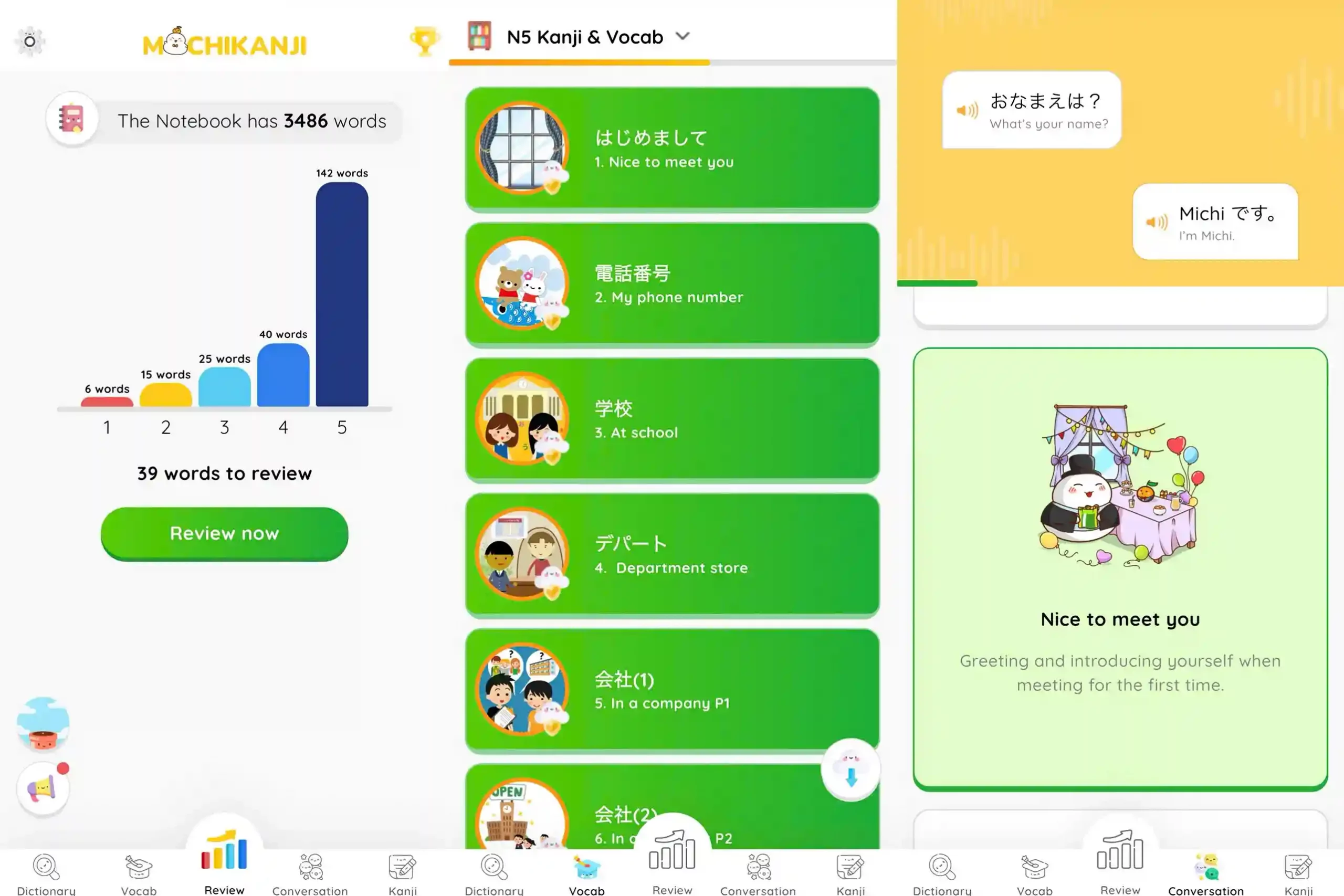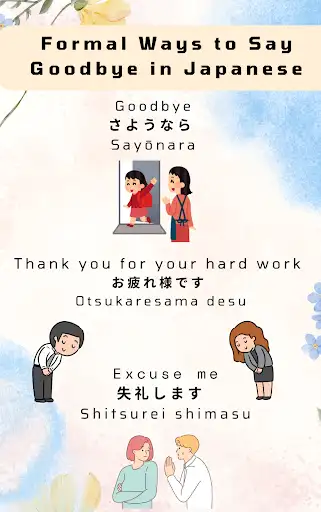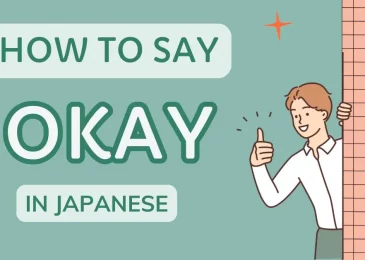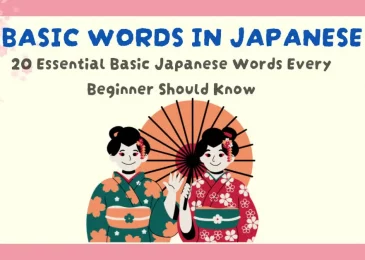- Why Saying Bye in Japanese Is Important
- Formal Ways to Say Bye in Japanese
- Casual Ways to Say Bye in Japanese
- Situational Farewells in Japanese
- Cultural Aspects of Saying Bye in Japan
- Common Mistakes to Avoid When Saying Bye in Japanese
- Practical Tips for Learning Japanese Farewells
Learning how to say “bye” in Japanese is essential for anyone exploring the language, whether for travel, work, or personal enrichment. Japanese culture places a strong emphasis on politeness and context, which extends to how farewells are expressed. In this guide, we’ll explore a variety of ways to say bye in Japanese, from formal expressions to casual phrases, ensuring you’re prepared for every situation.
Why Saying Bye in Japanese Is Important
In Japan, language is a reflection of respect and social harmony. The way you say goodbye can convey your feelings, respect for the other person, and your relationship with them. Whether you’re leaving a business meeting, parting ways with a friend, or ending a phone call, choosing the right expression matters.
Formal Ways to Say Bye in Japanese
1. さようなら (Sayōnara)
Meaning: Goodbye (formal)
“さようなら” is one of the most well-known Japanese farewells, but it carries a sense of finality. It’s typically used when parting for a long time or when you don’t anticipate seeing the person again in the near future. This could be at the end of a school year, after a significant event, or when moving away. Unlike casual farewells, it signals a more solemn departure.
Example:
先生、今年一年間ありがとうございました。さようなら。
(Sensei, kotoshi ichinenkan arigatou gozaimashita. Sayōnara.)
Translation: “Teacher, thank you for this year. Goodbye.”
Although “さようなら” is often taught as the standard way to say goodbye, it’s less commonly used in daily life. For shorter-term partings or in more casual situations, other phrases are preferred, as “さようなら” can feel overly formal or distant.
2. お疲れ様です (Otsukaresama desu)
Meaning: Thank you for your hard work / Goodbye (in a work context)
This phrase is indispensable in Japanese workplaces. It serves both as a form of acknowledgment for someone’s effort and as a polite way to say goodbye at the end of a workday. Whether you’re leaving the office or wrapping up a project, “お疲れ様です” shows appreciation and respect. It’s versatile, making it one of the most frequently used farewells in professional settings.
Example
今日も一日お疲れ様でした。失礼します。
(Kyō mo ichinichi otsukaresama deshita. Shitsurei shimasu.)
Translation: “Thank you for your hard work today. I’ll be leaving now.”
In less formal interactions, such as among close coworkers or team members, you can shorten it to お疲れ (Otsukare).
Example: じゃ、お疲れ!また明日!
(Ja, otsukare! Mata ashita!)
Translation: “Well, good work! See you tomorrow!”
3. 失礼します (Shitsurei shimasu)
Meaning: Excuse me / I’ll take my leave
This phrase is often used in formal or polite contexts when you’re leaving someone’s presence. It’s appropriate in situations like leaving a meeting, exiting someone’s office, or departing from a formal gathering. By saying “失礼します,” you’re acknowledging that you’re interrupting or excusing yourself, which demonstrates respect.
Example:
本日はお時間をいただき、ありがとうございました。それでは失礼します。
(Honjitsu wa ojikan o itadaki, arigatou gozaimashita. Soredewa shitsurei shimasu.)
Translation: “Thank you for your time today. I will take my leave now.”
In casual or friendly environments, you might opt for less formal expressions, but in business or formal settings, “失礼します” remains a staple. It’s especially important in hierarchical relationships, like when addressing clients or superiors.
Casual Ways to Say Bye in Japanese
Casual farewells in Japanese are commonly used among friends, family, and close acquaintances. These expressions convey warmth and familiarity, making them perfect for informal situations. Let’s dive into some of the most popular casual goodbyes and when to use them.
4. じゃね (Ja ne)
Meaning: See you / Bye
“じゃね” is a casual and friendly way to say goodbye, often used between friends, classmates, or close colleagues. It’s an informal phrase that implies you’ll see each other again, although the specific time may not be set. This phrase is equivalent to saying “See you” in English and is perfect for everyday use.
Example:
友達A: 今日は楽しかったね。またカフェ行こう!
(Kyō wa tanoshikatta ne. Mata kafe ikou!)
Friend A: “Today was fun. Let’s go to a café again sometime!”
友達B: そうだね!じゃね!
(Sō da ne! Ja ne!)
Friend B: “Yeah, totally! See you!”
While “じゃね” is informal, it’s a widely accepted way to part ways with someone you’re familiar with. Avoid using it in formal or professional contexts, as it might come across as too casual or even rude.
5. またね (Mata ne)
Meaning: See you later
Similar to “じゃね,” this phrase is informal but carries a slightly stronger implication that you’ll meet again soon. “また” means “again,” so “またね” directly translates to “again, okay?” or “See you later.” It’s suitable for use with friends, family, and others in your social circle.
Example:
学生A: 明日の授業、ちゃんと起きられるかな?
(Ashita no jugyō, chanto okirareru kana?)
Student A: “I wonder if I’ll be able to wake up for tomorrow’s class.”
学生B: 大丈夫だよ!またね!
(Daijōbu da yo! Mata ne!)
Student B: “You’ll be fine! See you later!”
“またね” can also be combined with other words to specify the next meeting time, such as また明日 (Mata ashita) for “See you tomorrow” or また今度 (Mata kondo) for “See you next time.”
6. バイバイ (Bai Bai)
Meaning: Bye-bye
Borrowed from English, “バイバイ” is an informal, lighthearted way to say goodbye. It’s popular among young people, children, and in casual settings. The phrase conveys a playful and relaxed tone, often accompanied by a wave. It’s also commonly used in conversations where a cheerful farewell is appropriate.
Example:
友達A: 今日はありがとう!
(Kyō wa arigatō!)
Friend A: “Thanks for today!”
友達B: こちらこそ!じゃ、バイバイ!
(Kochira koso! Ja, bai bai!)
Friend B: “Likewise! Bye-bye!”
“バイバイ” is highly informal, so it’s best reserved for friends or family members. It’s not typically used in professional or formal environments, where more appropriate farewells like “失礼します (Shitsurei shimasu)” would be expected.
Bye in Japanese: Situational Farewells
In Japanese, there are various expressions for saying goodbye, depending on the context and the nature of the relationship. Below are three situational farewells, along with detailed explanations and examples in Japanese.
7. 行ってきます (Ittekimasu) / 行ってらっしゃい (Itterasshai)
Meaning: “I’m leaving” / “Please go and come back safely”
These phrases are exchanged when someone is leaving home for a short period, like going to work or school. 行ってきます is said by the person leaving, and 行ってらっしゃい is the response from those staying behind. It reflects the expectation of a safe return.
Example:
子ども: 「行ってきます!」
母: 「行ってらっしゃい。気をつけてね。」
(Kodomo: “Ittekimasu!” / Haha: “Itterasshai. Ki o tsukete ne.”)
Translation:
Child: “I’m off!”
Mother: “Take care and come back safely.”
This simple exchange is a daily routine in Japanese households.
8. ただいま (Tadaima) / おかえりなさい (Okaerinasai)
Meaning: “I’m home” / “Welcome back”
These phrases are used when someone returns home. ただいま is said by the person who has come back, while おかえりなさい is the warm response from those already at home.
Example:
夫: 「ただいま!」
妻: 「おかえりなさい。今日もお疲れ様。」
(Otto: “Tadaima!” / Tsuma: “Okaerinasai. Kyō mo otsukaresama.”)
Translation:
Husband: “I’m home!”
Wife: “Welcome back. You must be tired today.”
This ritual strengthens family bonds and provides a sense of comfort after a day apart.
9. お元気で (Ogenki de)
Meaning: “Take care”
お元気で is often used for farewells involving a longer separation, such as when someone is moving away or traveling. It conveys good wishes for the other person’s health and well-being until you meet again.
Example:
友人: 「引っ越し、気をつけてね。お元気で!」
(Yūjin: “Hikkoshi, ki o tsukete ne. Ogenki de!”)
Translation:
Friend: “Take care while moving. Stay well!”
This farewell is often accompanied by a hopeful sentiment that the two will meet again in the future.
Bye in Japanese: Cultural Insights
In Japan, farewells are more than just verbal exchanges; they carry deep cultural significance and often involve non-verbal gestures and expressions. Understanding these nuances helps appreciate the thoughtfulness embedded in Japanese communication.
1. Bowing (お辞儀, Ojigi)
Bowing, or お辞儀 (ojigi), is a fundamental aspect of Japanese culture and is frequently used during goodbyes, especially in formal or respectful contexts. The angle and length of the bow vary depending on the relationship and situation. A slight nod around 15 degrees is common for casual goodbyes among friends or colleagues. A deeper bow of 30 to 45 degrees is reserved for more formal occasions, such as parting with a superior or a client. In highly formal situations, such as bidding farewell to a senior executive or after a significant event, the bow may last longer to show utmost respect. Beyond words, bowing conveys respect, gratitude, and humility, making it an integral part of farewells in business, social, and personal interactions. For instance, at the end of a business meeting, a subordinate may bow deeply while thanking their superior for the day
2. Waving (手を振る, Te o Furu)
In more casual and informal situations, waving, or 手を振る (te o furu), is a common gesture used for goodbyes, particularly among friends, family, or children. A wave often replaces a verbal farewell, especially when the parting is brief or less formal. It can also be used when distance prevents close interaction, such as saying goodbye from across the street or through a car window. This gesture adds a friendly and light-hearted touch to farewells, making it a versatile option. For example, a child might wave enthusiastically while shouting “バイバイ” (bye-bye) when leaving for school.
3. Expressions of Gratitude (感謝の表現, Kansha no Hyōgen)
In Japan, farewells often include expressions of gratitude, underscoring the importance of appreciating others before parting.
- ありがとう (Arigatou) or ありがとうございました (Arigatou gozaimashita):
These phrases are frequently added to goodbyes, especially in situations where someone has provided help, support, or company. It’s a way of acknowledging the other person’s contributions and ending the interaction on a positive note. - Deeper Cultural Meaning:
This habit reflects the Japanese value of fostering harmonious relationships and showing respect through acknowledgment. Gratitude during farewells reinforces mutual appreciation and leaves a lasting impression.
Example:
- After visiting a friend’s home:
「今日は楽しかったです。ありがとうございました。」(Kyō wa tanoshikatta desu. Arigatou gozaimashita.)
(“I had a great time today. Thank you so much.”)
Saying goodbye in Japan is a rich cultural practice that combines verbal and non-verbal elements. Whether through a respectful bow, a casual wave, or a heartfelt thank you, each farewell carries layers of meaning that reflect the importance of human connection in Japanese society
Common Mistakes to Avoid When Saying Bye in Japanese
Mastering Japanese farewells goes beyond memorizing phrases; understanding the social context is key. Here are some common mistakes to avoid:
1. Overusing さようなら (Sayōnara)
While さようなら is one of the first farewells learners encounter, it’s rarely used in daily conversations. This phrase conveys a sense of finality, making it suitable for long-term or permanent goodbyes, such as when moving away or ending a formal event. Using it in casual settings, like after a lunch with friends, may feel overly dramatic
Better alternatives: For casual goodbyes, use またね (matane, “See you later”) or じゃあ、また (jā, mata, “Well, see you”). In formal situations, opt for 失礼します (shitsurei shimasu, “Excuse me”) or お疲れ様です (otsukaresama desu, “Thank you for your hard work”)
2. Using Casual Phrases in Formal Settings
Casual farewells like じゃね (ja ne, “See ya”) or バイバイ (bai bai, “Bye-bye”) are fine among friends but inappropriate in professional contexts. Using these with superiors or clients can come across as unprofessional
What to use instead: In formal settings, use 失礼します or お世話になりました (osewa ni narimashita, “Thank you for your support”) to show respect
3. Ignoring Context and Relationship Dynamics
Japanese farewells must align with the context and relationship. For instance, using a phrase like またね with a superior or someone you’ve just met can feel too casual. Similarly, お疲れ様 (otsukaresama) is common among colleagues but should be used carefully with higher-ranking individuals
Key takeaway: Always consider the situation and hierarchy. When in doubt, choose a more formal expression to avoid causing offense
By avoiding these mistakes, you’ll improve your Japanese communication skills and demonstrate cultural sensitivity, which is highly valued in Japan.
Practical Tips for Learning Japanese Farewells
Mastering Japanese farewells requires more than rote memorization; it’s about understanding the cultural nuances and situational appropriateness. Here are some practical strategies to enhance your learning experience:
1. Practice with Native Speakers
Engaging with native speakers through language exchange partners, online communities, or professional tutors is one of the best ways to internalize Japanese farewells. These interactions allow you to practice not only the correct pronunciation but also the appropriate context for different phrases. A tutor can explain subtle differences between expressions like じゃあ、また (jā, mata, “See you later”) and 失礼します (shitsurei shimasu, “Excuse me”), helping you use them confidently in real-life situations
2. Watch Japanese Media
Immersing yourself in Japanese media, such as anime, dramas, or movies, provides valuable insights into how farewells are used in various contexts. You’ll notice that characters often use casual phrases like またね (matane) with friends, while formal farewells like お世話になりました (osewa ni narimashita) appear in workplace or professional settings. Observing these interactions helps reinforce your understanding of when and how to use different expressions
Tip: Try pausing scenes and repeating the phrases out loud to practice intonation and fluency
3. Use a Language App
Language learning apps are a great tool for reinforcing your knowledge of Japanese greetings. For more targeted learning, consider using MochiKanji—a language app specifically designed for mastering Japanese kanji and vocabulary.

MochiKanji provides a comprehensive course on basic Japanese conversation, integrating the spaced repetition system (SRS) to help you retain what you learn. SRS schedules reviews at optimal intervals to strengthen your memory, ensure you remember vocabulary in phrases just as you’re about to forget them. This method is highly effective for building a solid foundation in conversational Japanese, including mastering various ways to say goodbye.
Conclusion
Mastering how to say “goodbye” in Japanese involves understanding not only the language but also the culture and social norms. From formal farewells like さようなら to casual goodbyes like じゃね, each expression serves a specific purpose. By learning and practicing these phrases, you’ll not only improve your Japanese skills but also show respect and cultural awareness in your interactions.
So, next time you find yourself in a situation where you need to say goodbye in Japanese, you’ll know exactly what to say. Until then, またね!






